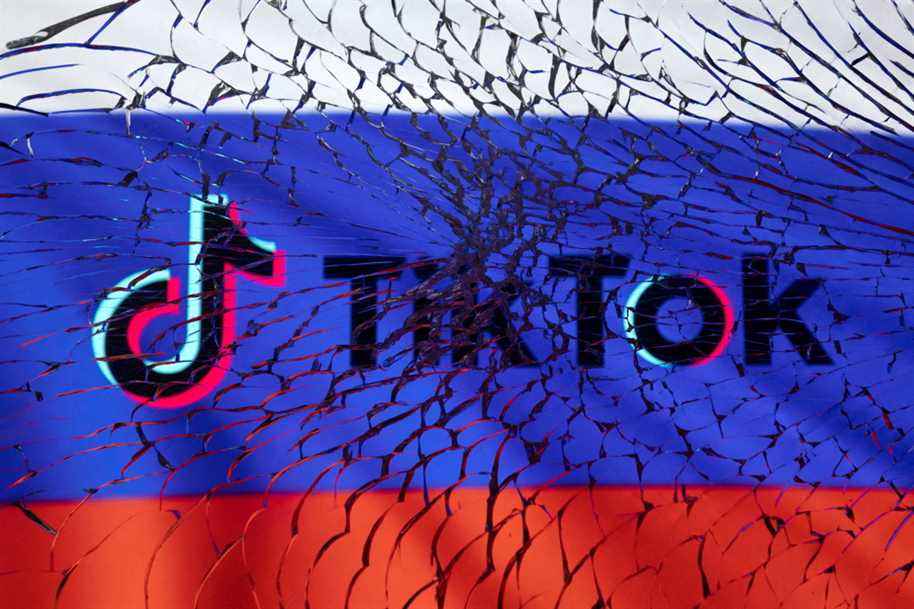Joke about the bombings, video of a walk in the rubble, live footage from an underground shelter: on TikTok, young Ukrainians use music and playful montages to tell their new daily life.
Posted at 5:00 a.m.
“You are the Anne Frank of TikTok. »
“Glad you can keep your joy and humor! »
Comments pile up under the almost daily posts of Valeria Shashenok, a resident of Chernihiv, in northern Ukraine.

SCREENSHOT FROM TIKTOK ACCOUNT @VALERISSSH
Valeria Shashenok in a video that has been viewed over 12 million times.
The 20-year-old photographer is the new darling of TikTok and Instagram. But she’s not promoting a new cosmetics brand or documenting her last visit to a trendy restaurant. The young Ukrainian instead offers short videos of her life spent between an airtight basement and her walks through her city, destroyed by Russian bombs.
The filmed sequences are punctuated with black humor and take up the aesthetic codes specific to TikTok: pop music, playful gestures, subtitles tinged with irony.
It has nearly 653,000 subscribers.
People describe me as the eyes of Gen Z. I do TikTok with humor because it’s a way of telling people what’s going on.
Valeria Shashenok, resident of Ukraine, in an interview with CNN earlier this week
She is not the only one to describe war, fear and danger with a destabilizing flippancy. Many of them use the aesthetic codes of influencers in their narration of the violence that is sweeping their country.
A young Ukrainian soldier has made dance videos his trademark. On the day of the Russian invasion, a young Ukrainian woman sways her hips and displays a blasé look. “Russia is attacking our country, so we have to leave at 8 a.m.,” she describes.
“New Dimension”
Humor, sarcasm and the second degree, powerful weapons in the face of the horror of a bloody invasion?
“It’s common to document your life on TikTok, but this brings a new dimension. It gives hope and it gives a face to the teenagers of this crisis, ”analyzes Laurence Grondin-Robillard, communications coordinator of the Multidisciplinary University Research Group on Daily Information and Surveillance (GRISQ).
We feel that this generation needs humor to get through this.
Laurence Grondin-Robillard, GRISQ communications coordinator
Accustomed to social media, adolescents and young adults have less modesty in relation to videos. They will not hesitate to document slices of their personal life and to make fun of dramatic moments, adds the doctoral student.
The invasion in Ukraine is not the first conflict to spread on social networks. The Arab Spring and the civil war in Syria were also unfolding before the eyes of Twitter and Facebook users, recalls Stéphane Couture, professor of communication at UQAM.
But this time, the young tiktokers understand how to use the codes to make their story go viral. “What’s new is the style and the staging. We have an increase in the snapshot and the personal point of view, but it remains content that informs us. Journalists take over these videos. »
The Russian blind spot
The blind spot of this virtual citizen mobilization is the absence of Russia. The teenagers who suffer the repercussions of the war in Putin’s country no longer have the right to express their indignation or daily anguish. Social network TikTok has suspended the ability to post new videos on its platform in Russia. A new law prohibits the dissemination of information aimed at discrediting the army and its invasion of Ukraine.
TikTok had almost 25 million users in Russia.
According to wall street journal, TikTok has also blocked access to content produced outside of Russia throughout that country. However, videos approved by the Russian state are allowed to circulate.
Blocking access to Western digital social media for Russians is very damaging, judges Mme Grondin-Robillard. “It locks them in an echo chamber. They will go to VKontakte, where pro-Putin propaganda is raining and where several conspirators have taken refuge. »
VKontakte, the Russian cousin of Facebook, is the most widely used social network in the country today.
Disinformation
The war in Ukraine is told through 20-second clips by the new generation. However, the trend is a breeding ground for misinformation, experts warn.
Many accounts, like ‘Warfare POV’, post sensationalized images of the conflict on Instagram to boost their following. In the majority of cases, it is impossible to confirm whether the images or audiovisual content are authentic.
“This is the first war we see live and on TikTok. We have never had a historic moment documented so quickly. It’s not by the day, it’s by the minute. It gives a big problem of checking the facts, ”adds Laurence Grondin-Robillard.

